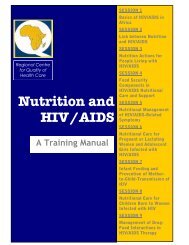2.1: Anthropometric Indicators Measurement Guide - Linkages Project
2.1: Anthropometric Indicators Measurement Guide - Linkages Project
2.1: Anthropometric Indicators Measurement Guide - Linkages Project
You also want an ePaper? Increase the reach of your titles
YUMPU automatically turns print PDFs into web optimized ePapers that Google loves.
9.<br />
There are a number of recommendations<br />
for different purposes. The reader is<br />
cautioned that some of the recommendations<br />
(including WHO) are being<br />
questioned (see Woodruff and Duffield,<br />
2000). The complex physiological<br />
changes, pubertal development, interethnic<br />
differences in genetic growth<br />
potential, and the different determinants<br />
of body size and shape makes rigid<br />
recommendations difficult.<br />
The recommendations for emergency<br />
screening should be for indicators that are<br />
easy to measure and do not require<br />
cumbersome or complicated equipment<br />
and procedures. The indicator should be<br />
determined taking into account differences<br />
between the survey and reference<br />
populations in age, sexual development<br />
and ethnicity. Most commonly found<br />
measurements in emergency situations<br />
are weight, height and mid-upper-armcircumference<br />
(MUAC). Measuring height<br />
can be challenging especially in<br />
emergency situations and for severely<br />
malnourished people who are feeble and<br />
disabled, height measurement may be<br />
impossible. The presence of famine<br />
edema is a serious indicator of nutritional<br />
stress and the accumulation of fluid<br />
distorts weight measures. Any situation of<br />
edema would be an indication for a range<br />
of nutrition interventions.<br />
For targeting interventions and<br />
assessing the situation, thinness measures<br />
are recommended. Thinness can be<br />
reflected by percent median weight-forheight<br />
or BMI-for-age and the Rohrer<br />
Index. Thinness is especially of concern<br />
among those adolescents who have not yet<br />
finished their growth spurt. Pregnancy<br />
adds weight to the girl and will distort the<br />
various weight based measures. During<br />
pregnancy, measures of weight change<br />
and MUAC are recommended.<br />
For assessing response to an<br />
intervention for adolescents, BMI should<br />
be used for programs designed to reduce<br />
the prevalence of thinness. BMI can be<br />
compared to local reference data or<br />
changes from pre- and post-intervention<br />
can be compared.<br />
It should be stressed that there is a lack<br />
of data to relate the specific indicator and<br />
its cutoff with health or survival<br />
outcomes. This means that to define<br />
undernutrition in adolescents, we do not<br />
have evidence of the choice of indicator or<br />
cutoff that exists with children under the<br />
age of five years. Weight for height and<br />
BMI indicators need to be examined based<br />
on an accurate determination of age. This<br />
may not be possible in many situations<br />
where age is unknown.<br />
The ACC/SCN recommend that<br />
clinical criteria be used for screening for<br />
therapeutic feeding. Surveys, they<br />
suggest, should correct for different ages<br />
of sexual maturation if the age of<br />
maturation in the survey population<br />
differs from the reference population.<br />
This is likely if the reference population is<br />
from a developed country.<br />
The recommendation for screening in<br />
Pre-Pubertal Adolescents, is to use weight<br />
for height as the index of choice (using<br />
weight for height reference standards).<br />
For Post-Pubertal Adolescents, BMI<br />
should be used and compared with the<br />
international reference standards.<br />
Height-for-age. The measure for height<br />
for estimating stunting during adolescence<br />
is the same as it is for young<br />
children. Stunting reflects chronic malnutrition.<br />
The height is compared to the<br />
height of adolescents of the same sex and<br />
age in the NCHS reference population.<br />
Growth charts for the US are available at:<br />
www.cdc.gov/growthcharts/. The cut off<br />
of

















